Neuro-Competence Approach for Sustainable Engineering
Abstract
:1. Introduction
- Science and Technology.
- Innovation and Entrepreneurship.
- Education and Training.
- Enable skills such as problem-solving, decision-making, leadership, team spirit, entrepreneurship and multiculturalism. Key to this is knowledge-sharing and social-learning.
- The implementation of the Learning Factory, focused on learning by doing, based on the dual approach.
- The development of digital skills and the integration of e-learning [22] in manufacturing, by strengthening the links between the academic and professional environment.
2. Materials and Methods
2.1. Bibliometric Study 1
- Data collection through the use of databases.
- Obtaining the units of analysis or KWs automatically using the software VOSviewer.
- Obtaining the co-occurrence frequency and similarity index using the aforementioned software.
- Graphic visualisation of the results obtained.
2.2. Bibliometric Study 2
3. Results
3.1. Results of the Bibliometric Study 1
- Digital transformation.
- Knowledge management.
- Learning systems.
- Life cycle.
3.2. Results of the Bibliometric Study 2
3.2.1. Literature Review of Connectivism
3.2.2. Proposal
- Areas 9 and 10: dorsolateral-anterior prefrontal cortex (DL-APFC).
- Area 44: pars opercularis.
- Area 45: pars triangularis.
- Area 46: dorsolateral prefrontal cortex (DL-PFC).
- Low level, where the uptake, registration and meaning of information, such as sensory, perceptual and attentional processes, take place.
- Medium level, involving memory, learning, oral and written communication.
- High level, such as reasoning, creativity, decision-making and problem-solving.
- The social perspective, taking into account attitude, culture and motivation.
- The cognitive perspective, focusing on social information processing.
- A perspective focusing on the neural substrates associated with the previous perspectives.
4. Discussion
5. Conclusions
Author Contributions
Funding
Institutional Review Board Statement
Informed Consent Statement
Data Availability Statement
Conflicts of Interest
References
- McKinsey & Company. The Future of German Mechanical Engineering. Operating Successfully in a Dynamic Environment; VDMA: Frankfurt, Germany, 2014. [Google Scholar]
- Carayannis, E.G.; Campbell, D.F.J. Triple helix, quadruple helix and quintuple helix and how do knowledge, innovation and the environment relate to each other? Int. J. Soc. Ecol. Sustain. Dev. 2010, 1. [Google Scholar] [CrossRef]
- Campbell, D.F.J.; Carayannis, E.G.; Rehman, S.S. Quadruple helix structures of quality of democracy in innovation systems: The usa, oecd countries, and eu member countries in global comparison. J. Knowl. Econ. 2015, 6, 467–493. [Google Scholar] [CrossRef]
- PwC. Megatrends: 5 Global Shifts Changing the Way We Live and Do Business; PwC: London, UK, 2018. [Google Scholar]
- OECD. Policy Perspectives, CIRCLE-Costs of Inaction and Resource Scarcity: Consequences for Long-Term Economic Growth; OECD: Paris, France, 2016. [Google Scholar]
- Stahel, W.R. Transición de Productos a Servicios: Venta de Prestaciones en Lugar de Venta de Bienes; Institut de la Durée: Geneva, Switzerland, 1998. [Google Scholar]
- Prieto-Sandoval, V.; Jaca, C.; Ormazabal, M. Economía circular: Relación con la evolución del concepto de sostenibilidad y estrategias para su implementación. Mem. Investig. Ing. 2017, 15, 85–95. [Google Scholar]
- MacArthur, E. Foundation Growth Within: A Circular Economy Vision for a Competitive Europe; Ellen MacArthur Foundation: Cowes, UK, 2015; p. 98. [Google Scholar]
- European Commission. Reflection Paper on The Social Dimension of Europe; European Commission: Brussels, Belgium, 2017. [Google Scholar]
- McKinsey & Company. Jobs Lost, Jobs Gained: Workforce Transition in a Time of Automation; McKinsey Global Institute: London, UK, 2017. [Google Scholar]
- Rødseth, H.; Eleftheriadis, R.; Lodgaard, E.; Fordal, J.M. Operator 4.0–Emerging job categories in manufacturing. Lect. Notes Electr. Eng. 2019, 484, 114–121. [Google Scholar] [CrossRef]
- Krugh, M.; McGee, E.; McGee, S.; Mears, L.; Ivanco, A.; Podd, K.C.; Watkins, B. Measurement of operator-machine interaction on a chaku-chaku assembly line. Procedia Manuf. 2017, 10, 123–135. [Google Scholar] [CrossRef]
- Romero, D.; Stahre, J.; Wuest, T.; Noran, O.; Bernus, P.; Fast-Berglund, Å.; Gorecky, D. Towards an operator 4.0 typology: A human-centric perspective on the fourth industrial revolution technologies. In Proceedings of the 46th International 172 Conference on Computers & Industrial Engineering, Tianjin, China, 29–31 October 2016. [Google Scholar]
- Longo, F.; Nicoletti, L.; Padovano, A. Smart operators in industry 4.0: A human-centered approach to enhance operators’ capabilities and competencies within the new smart factory context. Comput. Ind. Eng. 2017, 113, 144–159. [Google Scholar] [CrossRef]
- Büth, L.; Juraschek, M.; Posselt, G.; Herrmann, C. Supporting SMEs towards adopting mixed reality A training concept to bring the reality-virtuality continuum into application. Proceeding of the 2018 IEEE 16th International Conference on Industrial Informatics (INDIN), Porto, Portugal, 18–20 July 2018; IEEE: Piscataway, NJ, USA, 2018. [Google Scholar]
- Govindarajan, U.H.; Trappey, A.J.C.; Trappey, C.V. Immersive technology for human-centric cyberphysical systems in complex manufacturingprocesses: A comprehensive overview of the global patent profile using collective intelligence. Complexity 2018, 17. [Google Scholar] [CrossRef]
- Bourguignon, D. Closing the Loop. New Circular Economy Package; Europeen Parliament: Brussels, Belgium, 2016; p. 9. [Google Scholar]
- Comisión Europea. Comunicación De La Comisión Al Parlamento Europeo, Al Consejo, Al Comité Económico Y Social Europeo Y Al Comité De Las Regiones; Comisión Europea: Strasburg, France, 2020; p. 23. [Google Scholar]
- European Commission. White Paper on the Future of Europe: Reflections and Scenarios for The EU27 by 2025; European Commission: Strasburg, France, 2017. [Google Scholar]
- Manufuture High-Level Group. Manufuture Vision 2030: Competitive, Sustainable and Resilient European Manufacturing; Manufuture Implementation Support Group: Strasburg, France, 2018; Available online: http://www.manufuture.org/wp-content/uploads/Manufuture-Vision-2030_DIGITAL.pdf (accessed on 27 May 2019).
- ManuFUTURE High-Level Group. ManuFUTURE Vision 2030. 2018. Available online: http://rm-platform.com/images/DOCUMENTS/ManuFUTURE_Vision-2030_VC_30_05_2018.pdf (accessed on 28 May 2019).
- Vasconcelos, P.; Furtado, E.S.; Pinheiro, P.; Furtado, L. Multidisciplinary criteria for the quality of e-learning services design. Comput. Human Behav. 2020, 107, 105979. [Google Scholar] [CrossRef]
- SWD. Advancing Manufacturing-Advancing Europe-Report of the Task Force on Advanced Manufacturing for Clean Production; Europeen Commission: Brussels, Belgium, 2014. [Google Scholar]
- World Economic Forum. Technology and Innovation for the Future of Production: Accelerating Value Creation. White Paper; World Economic Forum: Cologny/Geneva, Switzerland, 2017. [Google Scholar]
- Burning Glass Technologies. Blurring Lines: How Business and Technology Skills are Merging to Create High Opportunity Hybrid Jobs. 2015. Available online: https://www.burning-glass.com/wp-content/uploads/Blurring_Lines_Hybrid_Jobs_Report.pdf (accessed on 11 July 2018).
- World Economic Forum Realizing Human Potential in the Fourth Industrial Revolution. An Agenda for Leaders to Shape the Future of Education, Gender and Work. White Paper; World Economic Forum: Cologny/Geneva, Switzerland, 2017. [Google Scholar]
- PwC Skills for Smart Industrial Specialisation and Digital Transformation; PwC: London, UK, 2018; ISBN 978-92-9202-385-0.
- Mayer, P. Guidelines for writing a review article. Zurich Basel Plant Sci. Cent. 2009, 82, 443–446. [Google Scholar]
- Jiménez, E. Los Métodos bibliométricos aplicaciones y estado de la cuestión. In Proceedings of the I Congreso Universitario de Ciencias de la Documentación. Teoría, Historia y Metodología de la Documentación en España (1975–2000), Madrid, Spain, 14–17 November 2000. [Google Scholar]
- Guzmán, M.V.; Trujillo, J.L. Los mapas bibliométricos o mapas de la ciencia: Una herramienta útil para desarrollar estudios métricos de información. Bibl. Univ. 2014, 16, 95–108. [Google Scholar] [CrossRef] [Green Version]
- Gobster, P.H. Mining the landscape: Themes and trends over 40 years of landscape and urban planning. Landsc. Urban. Plan. 2014, 126, 21–30. [Google Scholar] [CrossRef]
- Van Eck, N.J.; Waltman, L. Software survey: VOSviewer, a program for bibliometric mapping. Scientometrics 2010, 84, 523–538. [Google Scholar] [CrossRef] [PubMed] [Green Version]
- Centra, D.; Elbestawi, M.; Singh, I.; Wanyama, T. SEPT Learning Factory Framework. In Smart Industry & Smart Education; Springer: Cham, Switzerland, 2019; Volume 47. [Google Scholar] [CrossRef]
- Schallock, B.; Rybski, C.; Jochem, R.; Kohl, H. Learning factory for industry 4.0 to provide future skills beyond technical training. Procedia Manuf. 2018, 23, 27–32. [Google Scholar] [CrossRef]
- ElMaraghy, H.; Moussa, M.; ElMaraghy, W.; Abbas, M. Integrated product / system design and planning for new product family in a changeable learning factory. Procedia Manuf. 2017, 9, 65–72. [Google Scholar] [CrossRef]
- Elbestawi, M.; Centea, D.; Singh, I.; Wanyama, T. SEPT learning factory for industry 4.0 education and applied research. Procedia Manuf. 2018, 23, 249–254. [Google Scholar] [CrossRef]
- Enke, J.; Glass, R.; Kreß, A.; Hambach, J.; Tisch, M.; Metternich, J. Industrie 4.0–competencies for a modem production system a curriculum for learning factories. Procedia Manuf. 2018, 23, 267–272. [Google Scholar] [CrossRef]
- Küsters, D.; Praß, N.; Gloy, Y.S. Textile learning factory 4.0–preparing germany’s textile industry for the digital future. Procedia Manuf. 2017. [Google Scholar] [CrossRef]
- Romero, D.; Bernus, P.; Noran, O.; Stahre, J.; Berglund, Å.F. The operator 4.0: Human cyber-physical systems & adaptive automation towards human-automation symbiosis work systems. In IFIP Advances in Information and Communication Technology; Springer: Cham, Switzerland, 2016. [Google Scholar]
- Taylor, M.P.; Boxall, P.; Chen, J.J.J.; Xu, X.; Liew, A.; Adenijib, A. Operator 4.0 or Maker 1.0? Exploring the implications of Industrie 4.0 for innovation, safety and quality of work in small economies and enterprises. Comput. Ind. Eng. 2020, 139, 5. [Google Scholar] [CrossRef]
- Clinton, G.; Lee, E.; Logan, R. Connectivism as a framework for creative productivity in instructional technology. In Proceedings of the 2011 IEEE 11th International Conference on Industrial Informatics (INDIN), Bochum, Germany, 29–31 July 2013. [Google Scholar] [CrossRef]
- Siemens, G. Connectivism: Learning and knowledge today. Int. Rev. Res. Open Distance Learn. 2006, 9, 1–13. [Google Scholar]
- Salmon, G.; Siemens, G.; Ally, M. Connectivism: A learning theory for the digital age. Available online: https://jotamac.typepad.com/jotamacs_weblog/files/Connectivism.pdf (accessed on 15 January 2018).
- Wei, X.; Zhou, H. Functional design of the virtual learning community based on the connectivism learning theory. In Proceedings of the 2011 International Conference on Electrical and Control Engineering, Yichang, China, 16–18 September 2011. [Google Scholar]
- Ebner, M.; Lienhardt, C.; Rohs, M.; Meyer, I. Microblogs in higher education-a chance to facilitate informal and processoriented learning? Comput. Educ. 2009, 55, 92–100. [Google Scholar] [CrossRef]
- Hemmi, A.; Bayne, S.; Land, R. The appropriation and repurposing of social technologies in higher education. J. Comput. Assist. Learn. 2009, 25, 19–30. [Google Scholar] [CrossRef]
- Miralbell, O. Social networking sites and collaborative learning in tourism. eLC Res. Pap. Ser. 2014, 8, 56–67. [Google Scholar]
- Yusof, S.I.M.; Jumahat, T.; Mohamed, Z.; Ubaidullah, N.H. A measurement model of connectivism in adopting web 2.0. Adv. Sci. Lett. 2015, 21, 1684–1688. [Google Scholar] [CrossRef]
- Blot, G.; Saurel, P.; Rousseaux, F. Pattern discovery in e-learning courses: A timebased approach. In Proceedings of the 2nd International Conference on Control, Decision and Information Technologies, Metz, France, 3–5 November 2014. [Google Scholar]
- Downes, S. Connectivism and Connective Knowledge: Essays on Meaning and Learning Networks; National Research Council Canada: Ottawa, Canada, 2012; ISBN 978-1-105-77846-9. [Google Scholar]
- Rosa Yeh, C.; Singhateh, B. The effect of connectivism practices on organizational learning in Taiwan’s computer industry. Adv. Intell. Syst. Comput. 2013, 172, 219–229. [Google Scholar]
- Kop, R.; Carroll, F. Cloud computing and creativity: Learning on a massive open online course. Eur. J. Open Distance e-Learn. 2011, 14, 1–11. [Google Scholar]
- Ioannou, O. Design studio education in the online paradigm: Introducing online educational tools and practices to an undergraduate design studio course. In Proceedings of the 2017 IEEE Global Engineering Education Conference (EDUCON), Athens, Greece, 26–28 April 2017. [Google Scholar]
- Wasserman, S.; Faust, K. Social Network Analysis: Methods and Applications; Cambridge University Press: Cambridge, UK, 1994. [Google Scholar]
- Hurley, R.F.; Hult, G.T.M. Innovation, market orientation, and organizational learning: An integration and empirical examination. J. Mark. 1998, 62, 42–54. [Google Scholar] [CrossRef]
- Stacey, P. The pedagogy of MOOCs. Available online: https://empower.eadtu.eu/images/fields-of-expertise/OERsMOOCs/INNOQUAL-Issue-3-Publication-Sep-2014-FINAL-w-cover.pdf#page=118 (accessed on 7 March 2018).
- Rodríguez, C.O. Moocs and The AI-Standford Like Courses: Two Successful and Distinct Course Formats for Massive Open Online Courses; ERIC: Washington, DC, USA, 2012. [Google Scholar]
- Ebben, M.; Murphy, J.S. Unpacking MOOC scholarly discourse: A review of nascent MOOC scholarship. Learn. Media Technol. 2014, 39, 328–345. [Google Scholar] [CrossRef]
- Kop, R. The challenges to connectivist learning on open online networks: Learning experiences during a massive open online course. Int. Rev. Res. Open Distance Learn. 2011, 12, 19–38. [Google Scholar] [CrossRef]
- McKay, E. Macro-Level Learning through Massive Open Online Courses (MOOCs): Strategies and Predictions for the Future; McKay, E., Lenarcic, J., Eds.; IGI Global: Pennsylvania, PA, USA, 2015. [Google Scholar]
- Glušac, D.; Karuović, D.; Milanov, D. Massive open online courses–Pedagogical overview. In Proceedings of the 16th International Carpathian Control Conference (ICCC), Szilvásvárad, Hungary, 27–30 May 2015. [Google Scholar]
- Moreira, A.; Mota, J. The IMOOC pedagogical model: Bringing the gap between non-formal and formal education. In Proceedings of the V Congreso Internacional sobre Calidad y Accesibilidad de la Formación Virtual (CAFVIR 2014), Antigua Guatemala, Guatemala, 14–16 May 2014. [Google Scholar]
- Siemens, G. Learning and Knowing in Networks: Changing Roles for Educators and Designers. Presented at ITFORUM for Discussion. 27 January 2008. Available online: https://www.semanticscholar.org/paper/Learning-and-knowing-in-networks%3A-Changing-roles-Siemens/7658e432ffc19798da8501bd2bee46123ea57618 (accessed on 22 April 2018).
- Thiyagarajan, B.V. Revolution in teaching/MOOCs by the use of real-time face detection. In Proceedings of the 13th International Conference on Industrial Informatics (INDIN); IEEE: Piscataway, NJ, USA, 22–24 July 2015. [Google Scholar]
- Esposito, A. Research ethics in emerging forms of online learning: Issues arising from a hypothetical study on a MOOC. Electron. J. e-Learn 2012, 10, 315–325. [Google Scholar]
- Plumanns, L.; Printz, S.; Vossen, R.; Jeschke, S. Strategic management of personnel development in theindustry 4.0. In Proceedings of the 14th International Conference on Intellectual Capital, Knowledge Management and Organizational Learning (ICICKM 2017), Hong Kong, China, 7–8 December 2017. [Google Scholar]
- Suarez-Fernandez de Miranda, S.; Aguayo-González, F.; Salguero-Gómez, J.; Ávila-Gutiérrez, M.J. Life cycle engineering 4.0: A proposal to conceive manufacturing systems for industry 4.0 centred on the human factor (dfhfini4.0). Appl. Sci. 2020, 10, 4442. [Google Scholar] [CrossRef]
- Calleja, A.; Gonzalez, H.; Urbikain, G.; Pereira, O.; Rodriguez, A.; Lopez de Lacalle, L.N. Training and educacional oportunities at the aeronautics advanced manufacturing center cfaa upv/ehu. In Proceedings of the 12th Annual International Conference of Education, Research and Innovation (ICERI), Seville, Spain, 11–13 November 2019. [Google Scholar]
- Mark, J.; Thomas, N.; Kraft, A.; Casebeer, W.D.; Ziegler, M.; Ayaz, H. Neurofeedback for Personalized Adaptive Training. In Advances in Neuroergonomics and Cognitive Engineering, Proceedings of the AHFE 2020 Virtual Conferences on Neuroergonomics and Cognitive Engineering, and Industrial Cognitive Ergonomics and Engineering Psychology; Springer: Cham, Switzerland, 2021; Volume 586, pp. 83–94. [Google Scholar]
- Enríquez, P. Neurociencia Cognitiva; Sanz y Torres, S.L., Ed.; UNED: Madrid, Spain, 2014. [Google Scholar]
- Haykin, S.; Fuster, J.M. On cognitive dynamic systems: Cognitive neuroscience and engineering learning from each other. Proc. IEEE 2014, 102, 608–628. [Google Scholar] [CrossRef]
- Ormrod, J.E. Human Learning; Hall, M.P., Ed.; Pearson: London, UK, 2008. [Google Scholar]
- Silva-López, R.B.; Reyes-Ortiz, J.A.; Bravo, M.; Fallad, J.; Rodriguez, J. Techno neuro pedagogy system: An instructional design methodology for customized online courses (virtual customized environment learning). In Proceedings of the 2015 International Conference on Computational Science and Computational Intelligence, Las Vegas, NV, USA, 7–9 December 2015. [Google Scholar] [CrossRef]
- Benarós, S.; Lipina, S.J.; Segretin, M.S.; Hermida, M.J.; Jorge, J. A neuroscience and education: Towards the construction of interactive bridges. Rev. Neurol. 2010, 50, 179–186. [Google Scholar] [CrossRef]
- Pizarro, B. Neurociencia y educación; Muralla, L., Ed.; Editorial Médica Panamericana: Madrid, Spain, 2003. [Google Scholar]
- Iriarte, J.; Artieda, J. Manual de Neurofisiología Clínica; Editorial Médica Panamericana: Madrid, Spain, 2013; ISBN 9788491104810. [Google Scholar]
- Elhadi, A.M.; Kalb, S.; Martirosyan, N.L.; Agrawal, A.; Preul, M.C. Fedor Krause: The first systematic use of x-rays in neurosurgery. Neurosurg. Focus 2012, 33, E4. [Google Scholar]
- Loukas, M.; Pennell, C.; Groat, C.; Tubbs, R.S.; Cohen-Gadol, A.A. Korbinian Brodmann (1868–1918) and his contributions to mapping the cerebral cortex. Neurosurgery 2011, 68, 6–11. [Google Scholar] [CrossRef] [PubMed] [Green Version]
- Sanz de Acedo, M.L. Competencias Cognitivas en Educación Superior; de Narcea, S.A.E., Ed.; Editorial Médica Panamericana: Madrid, Spain, 2010; ISBN 978-84-277-1690-2. [Google Scholar]
- Hotte, R.; Basque, J.; Page-Lamarche, V.; Ruelland, D. Ingénierie des compétences et scénarisation pédagogique. Rev. Int. Technol. Pédagogie Univ. 2007, 4, 38–56. [Google Scholar]
- Le Boterf, G. Ingénierie et Évaluation Des Compétences, 6th ed.; Librairie Eyrolles: Paris, France, 2006. [Google Scholar] [CrossRef]
- Medina, A.; Domínguez, M.C. Didáctica. Formación Básica Para Profesores de la Educación; UNED: Madrid, Spain, 2012. [Google Scholar]
- Ryu, K.; Jung, M. Agent-based fractal architecture and modeling for developing distributed manufacturing systems. Int. J. Prod. Res. 2003, 41, 4233–4255. [Google Scholar] [CrossRef]
- Shin, M.; Mun, J.; Jung, M. Self-evolution framework of manufacturing systems based on fractal organization. Comput. Ind. Eng. 2009, 56, 1029–1039. [Google Scholar] [CrossRef]
- Lampón, J.F.; Cabanelas, P.; González-Benito, J. The impact of modular platforms on automobile manufacturing networks. Prod. Plan. Control 2017, 28, 335–348. [Google Scholar] [CrossRef]
- Downes, S. Toward Personal Learning: Reclaiming a Role for Humanity in a World of Commercialism and Automation; Version 9; National Research Council Canada: Ottawa, Canada, 2017. [Google Scholar]
- Kernberg, O.F. Neurobiological correlates of object relations theory: The relationship between neurobiological and psychodynamic development. Int. Forum Psychoanal. 2015, 24, 38–46. [Google Scholar] [CrossRef]
- Goleman, D. Inteligencia Social: La Nueva Ciencia de las Relaciones Humanas; Editorial Kairós: Barcelona, España, 2006; ISBN 978-84-7245-779-9. [Google Scholar]
- Reeves, L.M.; Schmorrow, D.D.; Stanney, K.M. Augmented cognition and cognitive state assessment technolog -Near-term, mid-term, and long-term research objectives. In Foundations of Augmented Cognition, Proceedings; Schmorrow, D.D., Reeves, L.M., Eds.; Springer: Cham, Switzerland, 2007; Volume 4565, p. 220. ISBN 978-3-540-73215-0. [Google Scholar]
- Kruse, A.A. Operational neuroscience: Neurophysiological measures in applied environments. Aviat. Space Environ. Med. 2007, 78, B191–B194. [Google Scholar] [PubMed]
- Ochsner, K.N.; Lieberman, M.D. The emergence of social cognitive neuroscience. Amer. Psychol. 2001, 56, 717–734. [Google Scholar] [CrossRef]
- Olsson, A.; Ochsner, K.N. The role of social cognition in emotion. Trends Cogn. Sci 2008, 12, 65–71. [Google Scholar] [CrossRef] [Green Version]
- Wiltshire, T.; Fiore, S.M. Social cognitive and affective neuroscience in human-machine systems: A roadmap for improving trainig, human-robot interaction and team performance. IEEE Trans. Human Mach. Syst. 2014, 44, 779–787. [Google Scholar] [CrossRef]
- Wiltshire, T.J.; Barber, D.; Fiore, S.M. Towards modeling social cognitive mechanisms in robots to facilitate human-robot teaming. Proc. Hum. Factors Ergon. Soc. Annu. Meet. 2013, 57, 1273–1277. [Google Scholar] [CrossRef]
- Lobato, E.J.C.; Wiltshire, T.J.; Fiore, S.M. A dual-process approach to human-robot interaction. Proc. Hum. Factors Ergon. Soc. Annu. Meet. 2013, 57, 1263–1267. [Google Scholar] [CrossRef]
- Bohl, V.; Van den Bos, W. Toward an integrative account of social cognition: Marrying theory of mind and interactionism to study the interplay of type 1 and type 2 processes. Front. Hum. Neurosci. 2012, 6, 1–15. [Google Scholar] [CrossRef] [Green Version]
- Gallagher, S. Direct perception in the intersubjective context. Conscious. Cogn. 2008, 17, 535–543. [Google Scholar] [CrossRef] [PubMed] [Green Version]
- Wilkinson, M.R.; Ball, L.J. Dual Processes in Mental State Understanding: Is Theorising Synonymous with Intuitive Thinking and Is Simulation Synonymous with Reflective Thinking? Available online: https://escholarship.org/content/qt8p76w4xc/qt8p76w4xc_noSplash_a51edb2b8e7db5ef3e222829c323d8ac.pdf (accessed on 12 June 2017).
- Barakova, E.I.; Lourens, T. Mirror neuron framework yields representations for robot interaction. Neurocomputing 2009, 72, 895–900. [Google Scholar] [CrossRef]
- Oberman, L.M.; McCleery, J.P.; Ramachandran, V.S.; Pineda, J.A. EEG evidence formirror neuron activity during the observation of human and robot actions: Toward an analysis of the human qualities of interactive robots. Neurocomputing 2007, 70, 2194–2203. [Google Scholar] [CrossRef]
- Krach, S.; Hegel, F.; Wrede, B.; Sagerer, G.; Binkofski, F.; Kircher, T. Can machines think? Interaction and perspective taking with robots investigated via fMRI. PLoS ONE 2008, 3, 1–11. [Google Scholar] [CrossRef] [PubMed]
- Molina, G.; Tsoneva, T.; Nijholt, A. Emotional brain–computer interfaces. Int. J. Auton. Adapt. Commun. Syst. 2013, 6, 9–25. [Google Scholar] [CrossRef]
- Millan, J.R.; Renkens, F.; Mouriño, J.; Gerstner, W. Noninvasive brainactuated control of a mobile robot by human EEG. EEE Trans. Biomed. Eng. 2004, 51, 1026–1033. [Google Scholar] [CrossRef] [PubMed] [Green Version]
- Immordino-Yang, M.H.; Damasio, A. We feel, therefore we learn: The relevance of affective and social neuroscience to education. Mind Brain Educ. 2007, 1, 3–10. [Google Scholar] [CrossRef]
- Immordino-Yang, M.H. Implications of Affective and Social Neuroscience for Educational T-heory. Educ. Philos. Theory 2011, 43, 98–103. [Google Scholar] [CrossRef]
- Saritas, M.T. The Emergent Technological and Theoretical Paradigsn in Education: The Interrelations of Cloud Computing (CC), Conectivism and Internet of things (IoT). Proc. Acta Polytech. Hung. 2015, 12, 161–179. [Google Scholar] [CrossRef]
- Suárez Fernández-Miranda, S.; Aguayo González, F.; Salguero Gómez, J.; Gámez López, A.J. Redes de recursos del director de proyectos: Conectivismo. In Proceedings of the 23rd International Congress on Project Management and Engineering, Malaga, Spain, 10–12 July 2019; pp. 1–9. [Google Scholar]
- Clarke, E.; DeNora, T.; Vuoskoski, J. Music, empathy and cultural understanding. Phys. Life Rev. 2015, 15, 61–88. [Google Scholar] [CrossRef]
- Sannino, A.; Engestrom, Y. Cultural-historical activity theory: Founding insights and new challenges. Kult. Psikhologiya Cult. Hist. Psychol. 2018, 14, 43–56. [Google Scholar] [CrossRef]
- Barab, S.; Schatz, S.; Scheckler, R. Using activity theory to conceptualize online community and using online community to conceptualize activity theory. Mind Cult. Act. 2004, 11, 25–47. [Google Scholar] [CrossRef]
- Treur, J.; van Wissen, A. Computational Analysis of the Impacts of Emotion on Learning in a Social Context; Zhong, N., Gong, Z., Cheung, Y.M., Santos, E., Tianfield, H., Lau, H.C., Eds.; IEEE Computer Society Press: New York, NY, USA, 2012; ISBN 978-0-7695-4880-7. [Google Scholar]

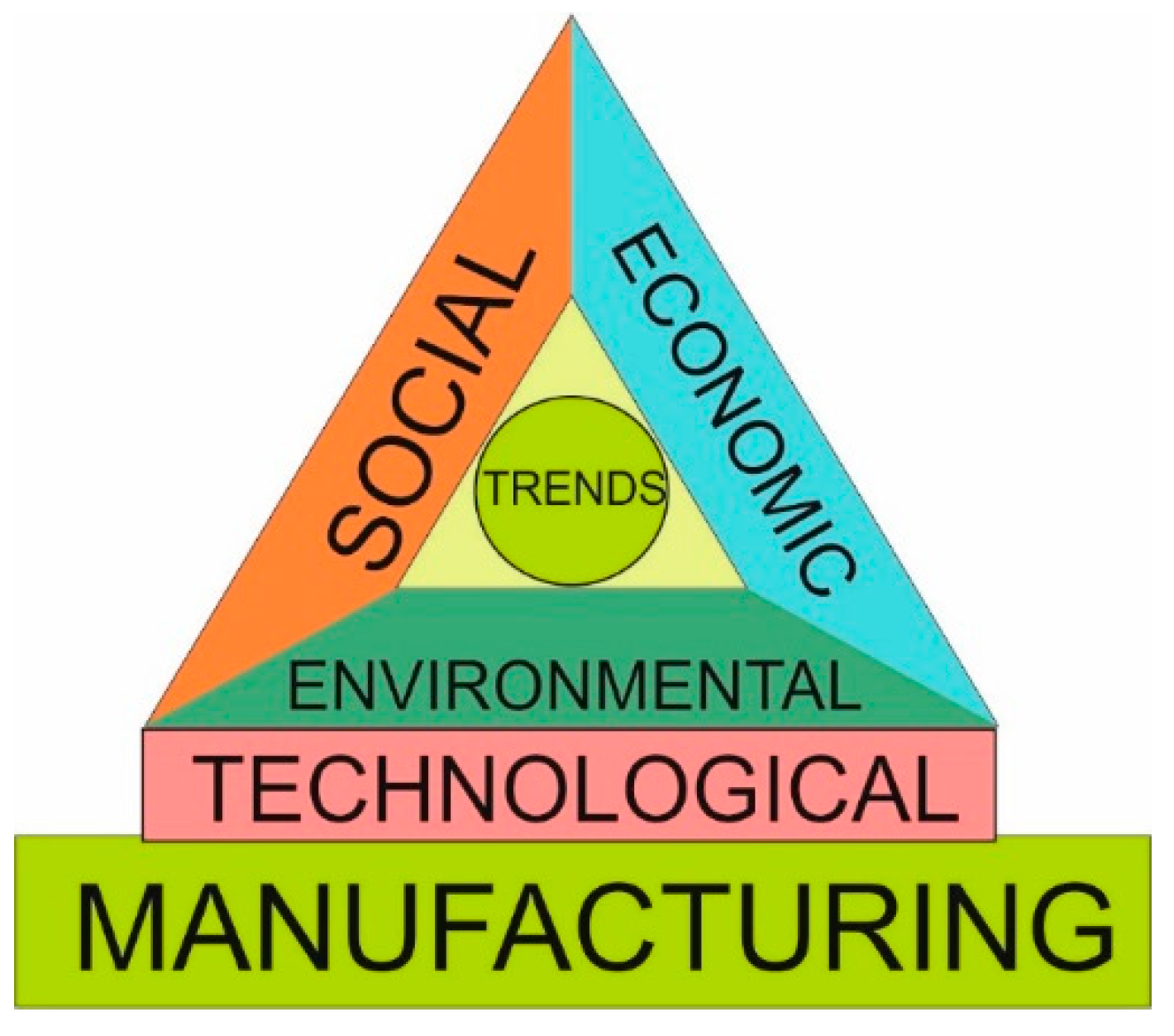
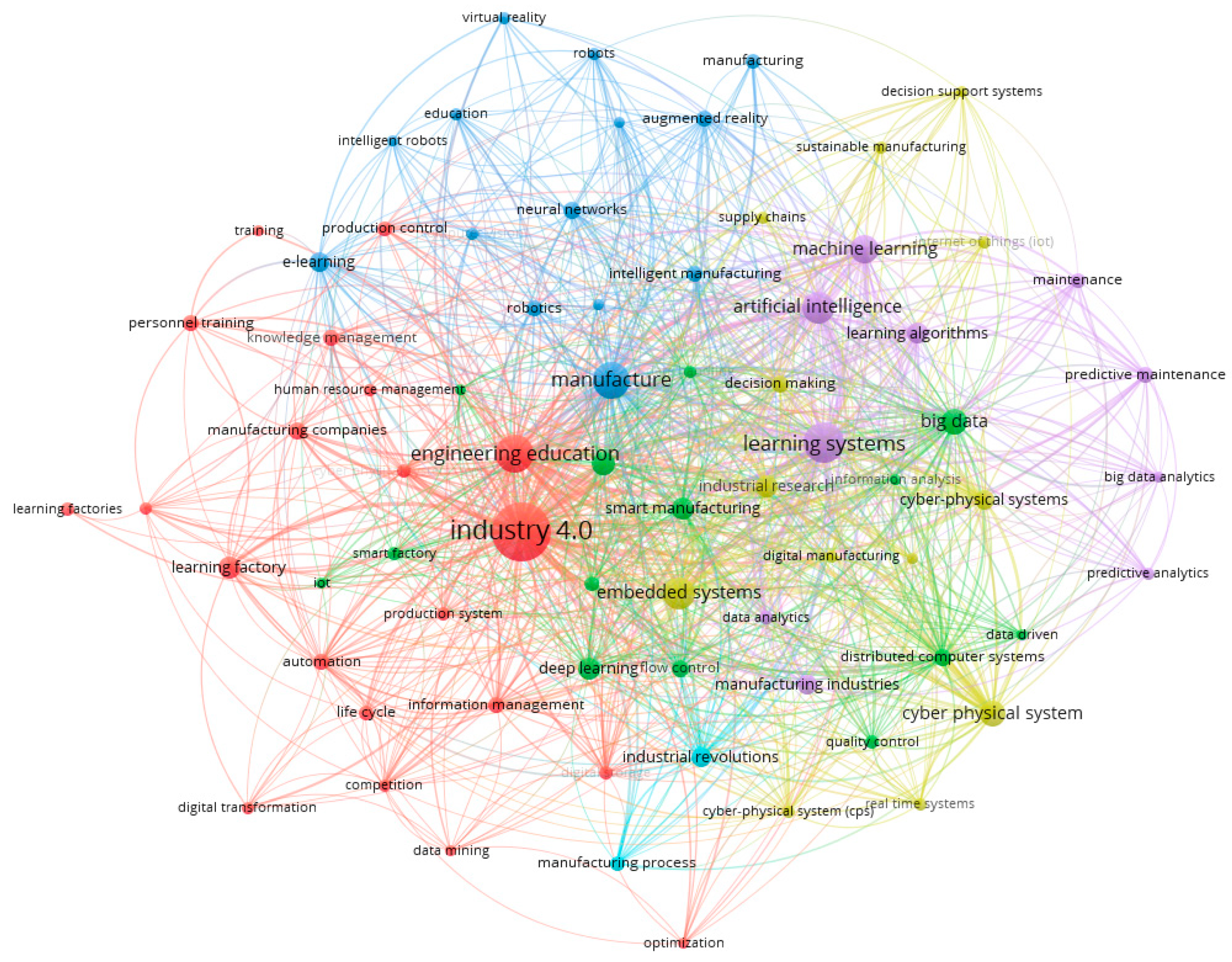
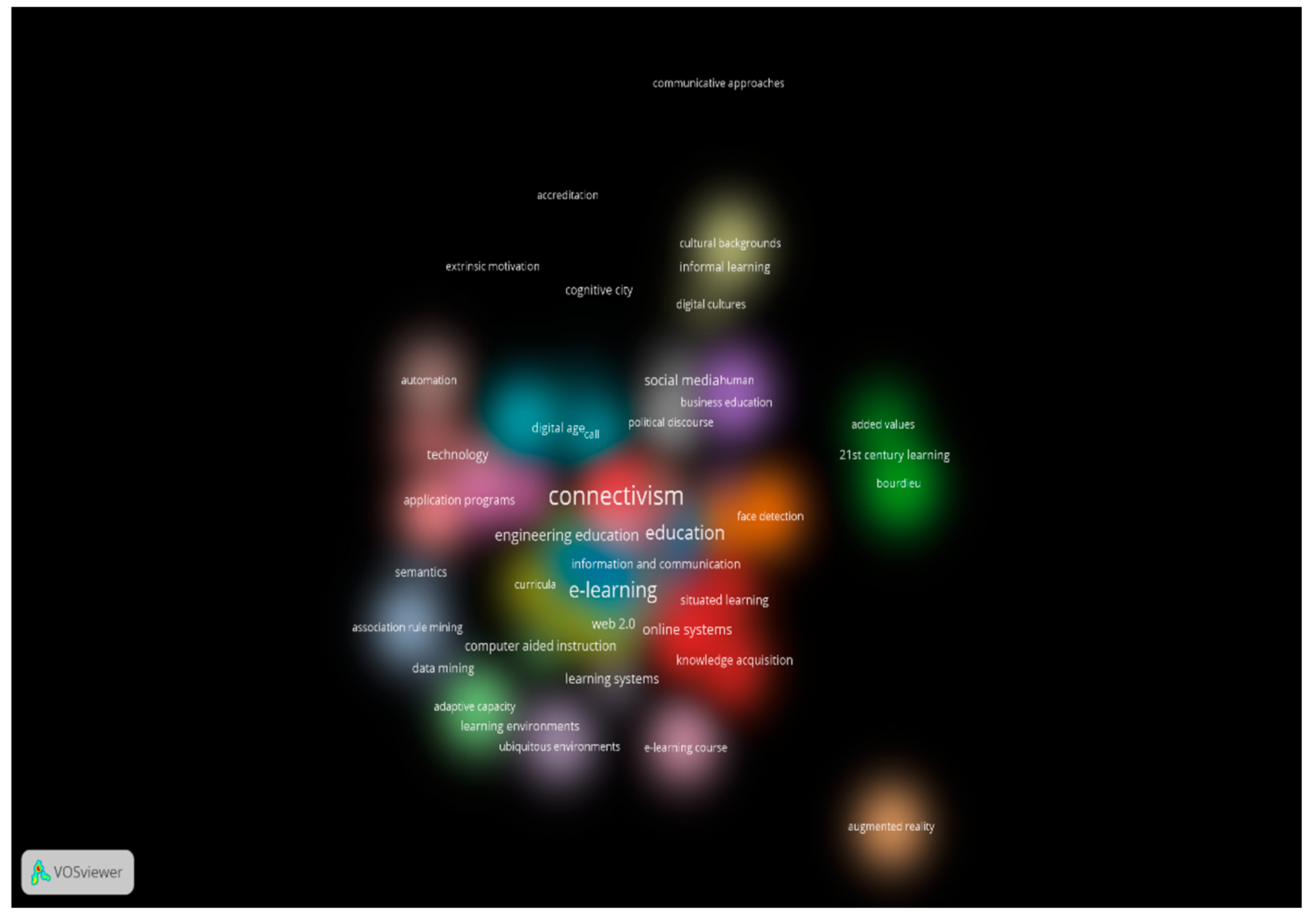
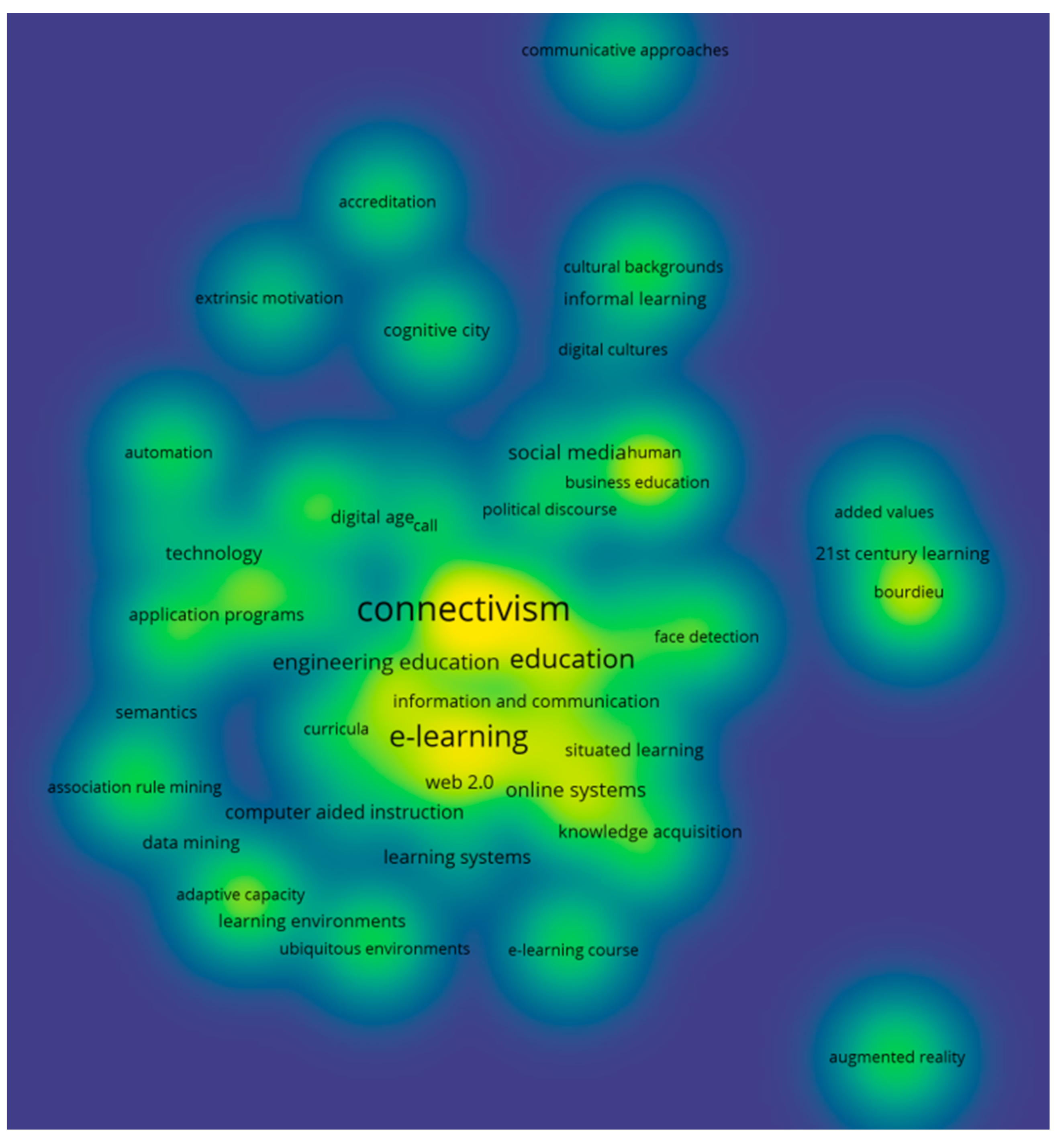

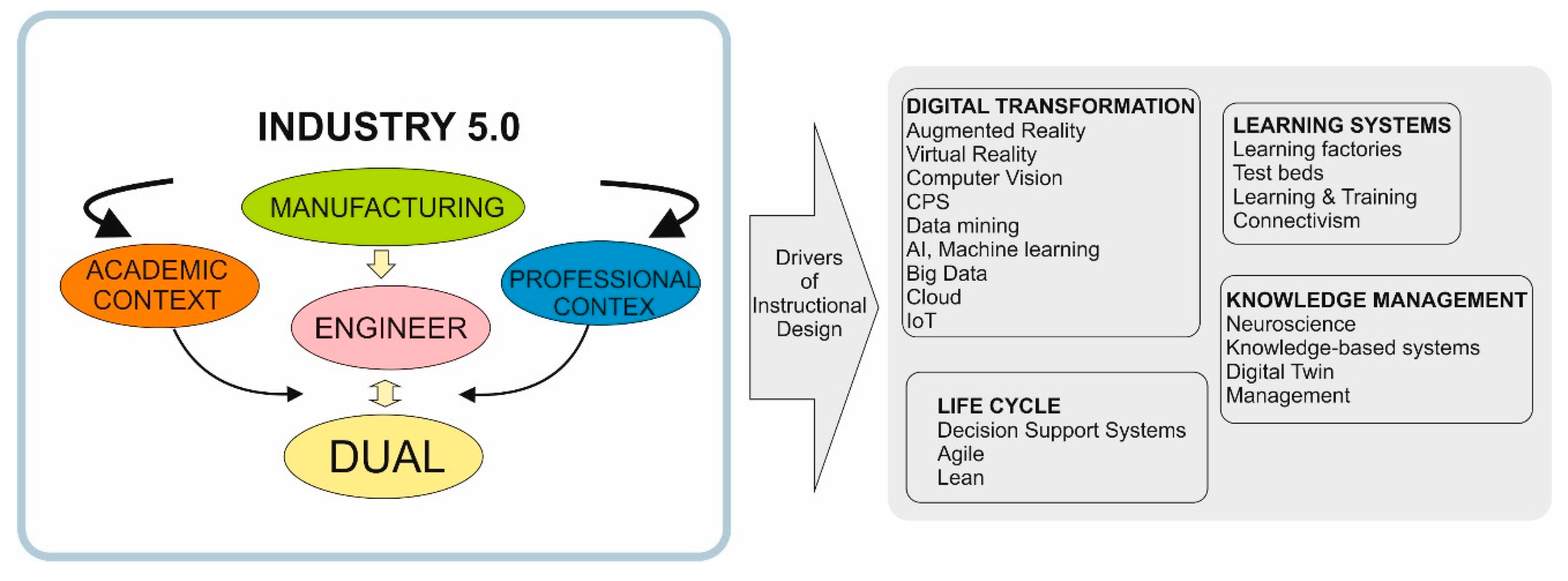
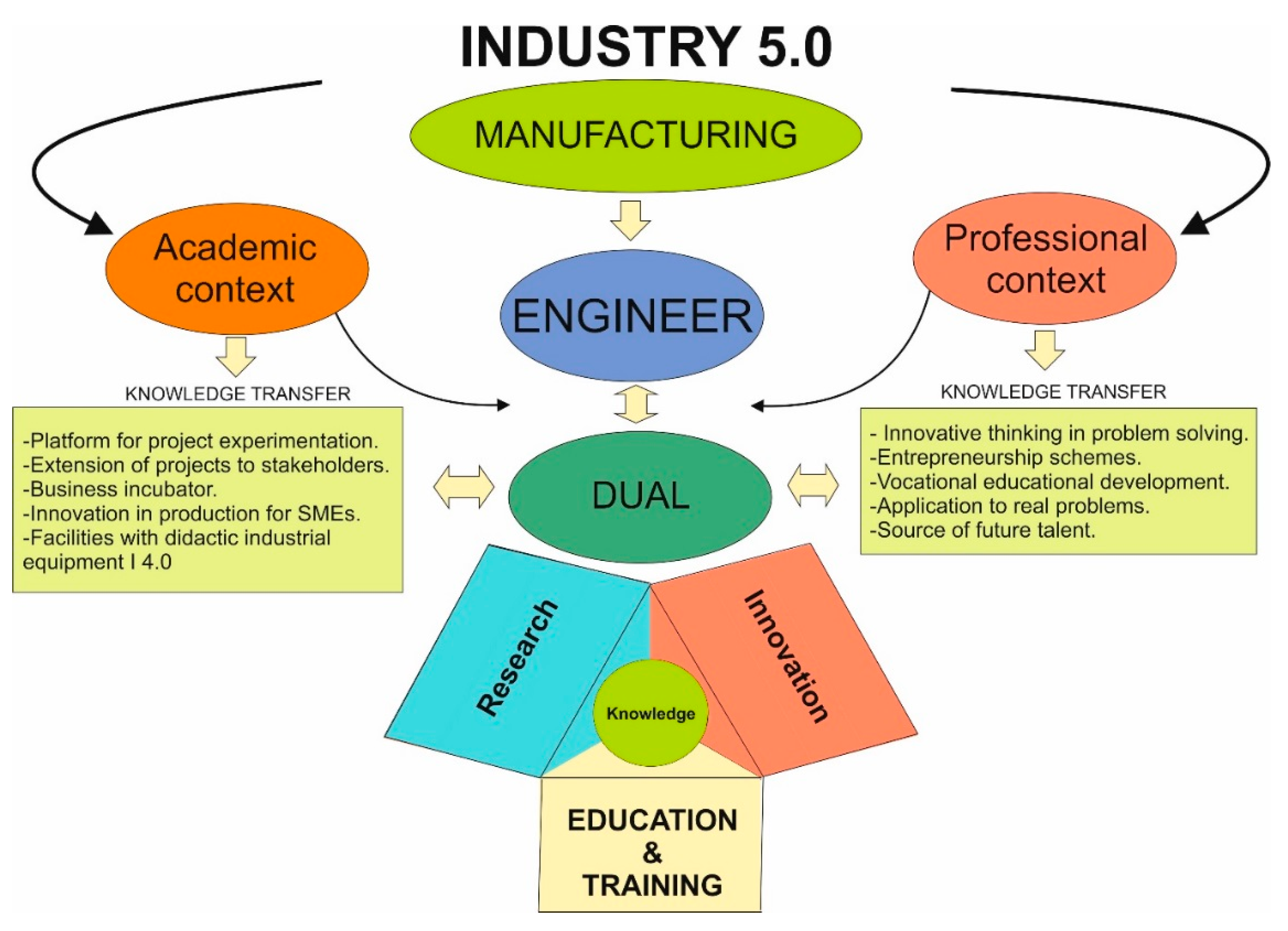

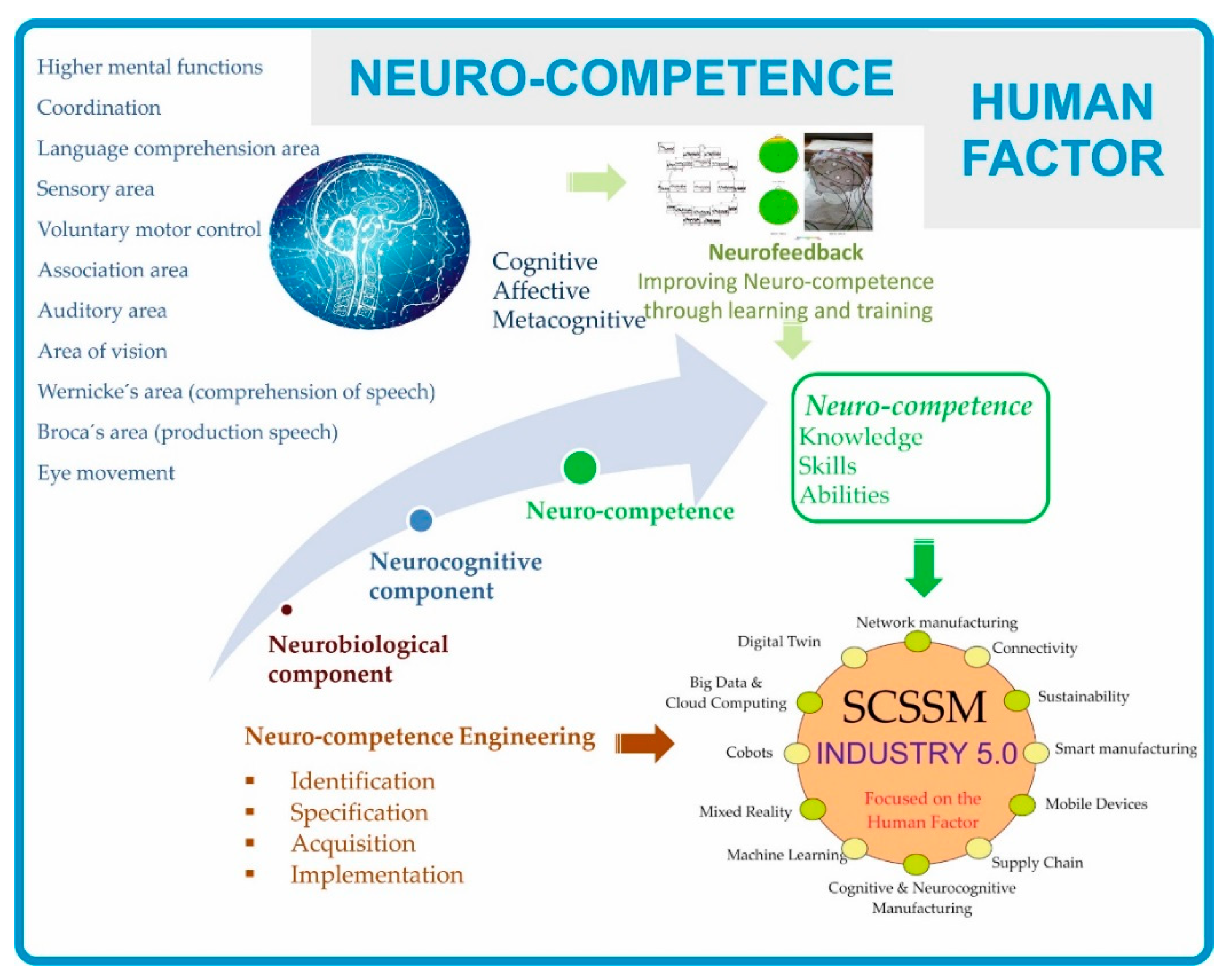

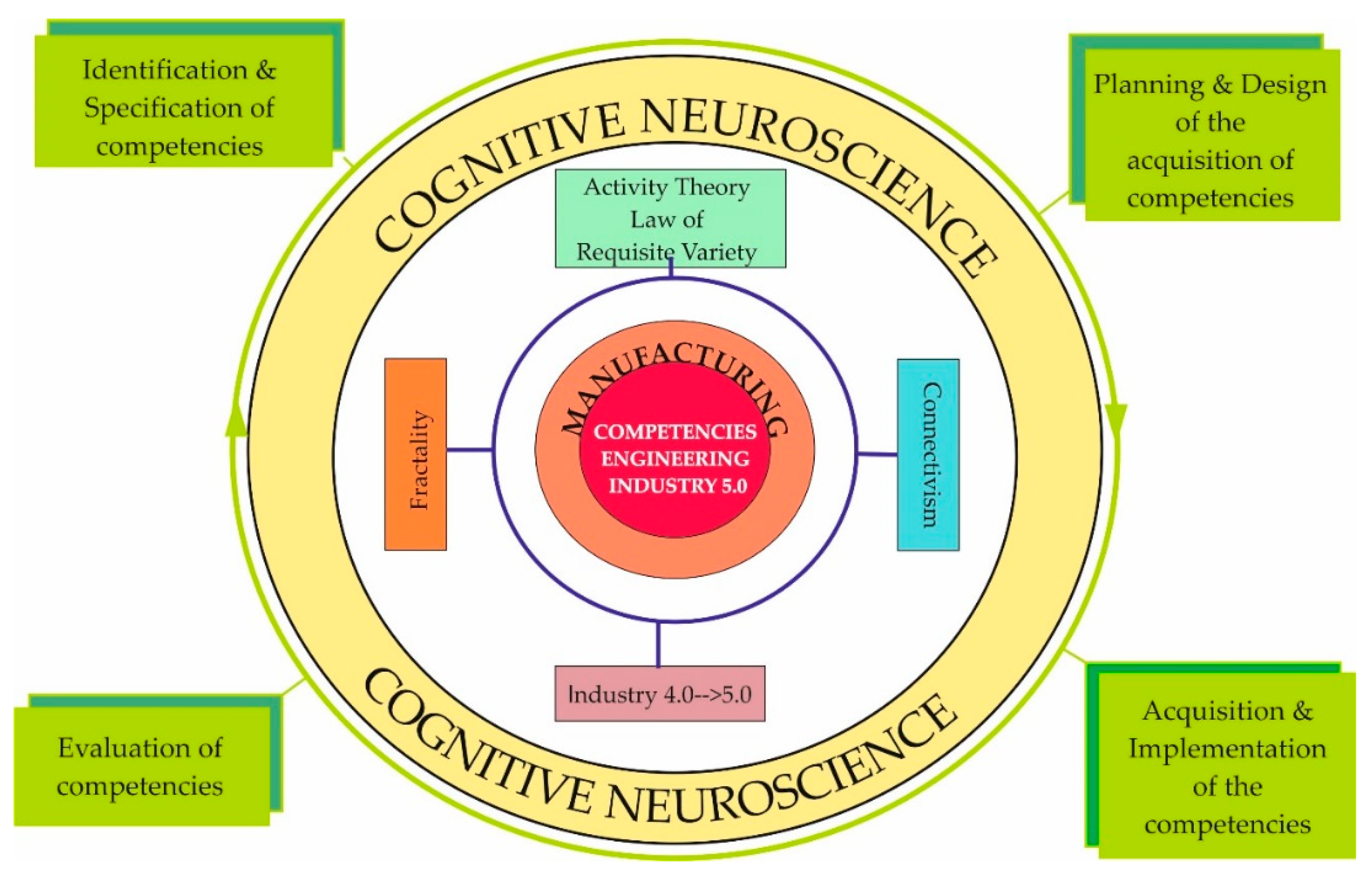

| Area: Learning Systems | |||
|---|---|---|---|
| Drivers | References | Authors | |
| Learning Factory | [33] | Centea, D.; Elbestawi, M.; Singh, I.; Wanyama, T. | |
| [34] | Schallock, B.; Rybski, C.; Jochem, R.; Kohl, H. | ||
| Test Beds | [35] | ElMaraghy, H.; Moussa, M.; ElMaraghy, W.; Abbas, M. | |
| [36] | Elbestawi, M.; Centea, D.; Singh, I.; Wanyama, T. | ||
| Learning | [37] | Enke, J.; Glass, R.; Kreß, A.; Hambach, J.; Tisch, M.; Metternich, J. | |
| [38] | Küsters, D.; Praß, N.; Gloy, Y.S. | ||
| Training | [39] | Romero, D.; Bernus, P.; Noran, O.; Stahre, J.; Berglund, Å.F. | |
| [40] | Taylor, M.P.; Boxall, P.; Chen, J.J.J.; Xu, X.; Liew, A.; Adenijib, A. | ||
| Connectivism | [41] | Clinton, G.; Lee, E.; Logan, R. | |
| [42] | Siemens, G. | ||
| Keyword | Occurrences | Total Link Strength |
|---|---|---|
| connectivism | 27 | 325 |
| e-learning | 16 | 215 |
| education | 12 | 186 |
| teaching | 10 | 143 |
| students | 9 | 141 |
| social networking (online) | 8 | 109 |
| collaborative learning | 5 | 66 |
| engineering education | 5 | 75 |
| knowledge management | 5 | 74 |
| online systems | 4 | 59 |
| social media | 4 | 49 |
| computer aided instruction | 3 | 55 |
| distance education | 3 | 45 |
| learning systems | 3 | 42 |
| moocs | 3 | 32 |
| social learning | 3 | 30 |
| social networks | 3 | 53 |
| technology | 3 | 41 |
| virtual reality | 3 | 51 |
| web 2.0 | 3 | 22 |
| world wide web | 3 | 38 |
| 21st century learning | 2 | 33 |
| application programs | 2 | 29 |
| assessment | 2 | 14 |
| cognitive city | 2 | 10 |
| data mining | 2 | 35 |
| digital age | 2 | 31 |
| educational technology | 2 | 30 |
| fuzzy logic | 2 | 10 |
| higher education | 2 | 17 |
| informal learning | 2 | 16 |
| information and communication technologies | 2 | 33 |
| innovation | 2 | 20 |
| knowledge acquisition | 2 | 17 |
| learning | 2 | 12 |
| learning activity | 2 | 21 |
| learning analytics | 2 | 14 |
| learning environments | 2 | 34 |
| on-line education | 2 | 24 |
| online | 2 | 19 |
| problem solving | 2 | 22 |
| semantics | 2 | 33 |
| situated learning | 2 | 14 |
| smart city | 2 | 10 |
| websites | 2 | 35 |
| 5-dimensional evaluation model | 1 | 19 |
| academic resilience | 1 | 11 |
| accreditation | 1 | 10 |
| activity coefficients | 1 | 14 |
| activity theory | 1 | 14 |
| adaptive capacity | 1 | 20 |
| References | Authors | Title |
|---|---|---|
| [44] | Wei, X.; Zhou, H. | Functional design of the virtual learning community based on the connectivism learning theory |
| [45] | Ebner, M., Lienhardt, C., Rohs, M. & Meyer, I. | Microblogs in higher education-a chance to facilitate informal and process-oriented learning? |
| [46] | Hemmi, A., Bayne, S. & Land, R. | The appropriation and repurposing of social technologies in higher education |
| [47] | Miralbell, O. | Social networking sites and collaborative learning in tourism |
| [48] | Yusof, S.I.M., Jumahat, T., Mohamed, Z., Ubaidullah, N.H. | A measurement model of connectivism in adopting web 2.0 |
| [49] | Blot, G., Saurel, P., Rousseaux, F. | Pattern discovery in e-learning courses: A time-based approach |
| [50] | Downes, S. | Connectivism and Connective Knowledge: essays on meaning and learning networks |
| [51] | Rosa Yeh, C., Singhateh, B. | The effect of connectivism practices on organizational learning in Taiwan’s computer industry |
| [52] | Kop, R., Carroll, F. | Cloud computing and creativity: learning on a massive open online course |
| [53] | Ioannou, O. | Design studio education in the online paradigm: Introducing online educational tools and practices to an undergraduate design studio course |
Publisher’s Note: MDPI stays neutral with regard to jurisdictional claims in published maps and institutional affiliations. |
© 2021 by the authors. Licensee MDPI, Basel, Switzerland. This article is an open access article distributed under the terms and conditions of the Creative Commons Attribution (CC BY) license (https://creativecommons.org/licenses/by/4.0/).
Share and Cite
Suarez-Fernandez de Miranda, S.; Aguayo-González, F.; Ávila-Gutiérrez, M.J.; Córdoba-Roldán, A. Neuro-Competence Approach for Sustainable Engineering. Sustainability 2021, 13, 4389. https://doi.org/10.3390/su13084389
Suarez-Fernandez de Miranda S, Aguayo-González F, Ávila-Gutiérrez MJ, Córdoba-Roldán A. Neuro-Competence Approach for Sustainable Engineering. Sustainability. 2021; 13(8):4389. https://doi.org/10.3390/su13084389
Chicago/Turabian StyleSuarez-Fernandez de Miranda, Susana, Francisco Aguayo-González, María Jesús Ávila-Gutiérrez, and Antonio Córdoba-Roldán. 2021. "Neuro-Competence Approach for Sustainable Engineering" Sustainability 13, no. 8: 4389. https://doi.org/10.3390/su13084389
APA StyleSuarez-Fernandez de Miranda, S., Aguayo-González, F., Ávila-Gutiérrez, M. J., & Córdoba-Roldán, A. (2021). Neuro-Competence Approach for Sustainable Engineering. Sustainability, 13(8), 4389. https://doi.org/10.3390/su13084389









